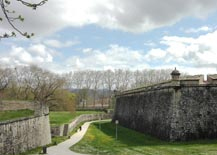
Locality: PAMPLONA (31001)
Zone: The Pamplona Basin
Interesting links www.pamplona.net
Centuries of construction: XVI-XX
Description
The five-kilometre walls around the city create an unusual and evocative stroll around its history. The city walls of Pamplona are one of the most interesting and best preserved military structures in Spain and hold the status of National Monument.
As a medieval city, Pamplona surrounded itself with walls to defend itself against invaders, although it was not until the incorporation of the Kingdom of Navarre into the Crown of Castile in 1512 that its strategic location turned it into an advanced post of the Spanish crown against France.
The development of fortress
The development of the great and formidable fortress began at that time and has its high point in the Citadel. Bastions gates, half-moons, ravelins, forts… all give the walled enclosure the sobriety and sophistication of this kind of defensive system.
Pamplona’s urban development in the 20th century meant that some sections had to be demolished so that the modern city could expand. Its essence remains, however.
A walk along the path around the walls, which runs between the Media Luna and Taconera parks, combines the coldness and silence of the stones with the warm and welcoming green landscape in the background.
Ring around the city wall
Medieval Pamplona’s walled enclosure was initially structured around its different boroughs (San Cernin, San Nicolas and Navarrería) and made up a ring around the whole city after the Privilegio de la Unión (1423), a treaty that united the three ancient boroughs of the city.
Following the annexation of Navarre to Castile in 1512, Pamplona became an advanced staging post of the Spanish crown against France, and for three centuries became the defender of the frontier against possible invasion.
This explains the interest of Ferdinand of Aragon and his Hapsburg descendents in converting Pamplona into an impregnable city, and its defences were designed according to the latest military architecture.
In 1571 Felipe ordered the building of the Citadel, a real milestone in the fortified city’s history, and work started on improving the walled defences over the following decades.
The bastions
If you follow the route from Media Luna park you come to the bastions of Labrit, Redín, Guadalupe, Pilar, Abrevador, Parma, Gonzaga and La Taconera, and in the Citadel those of Santiago, Santa María and Real.
Counterguards, windows (San Bartolomé, San Roque), ravelins (such as Los Reyes), and forts (San Bartolomé, San Roque and del Príncipe) completed the complex defensive system of Pamplona. It made no concessions to style and its power, robustness and sobriety can be seen in its stones and the strength of the walls.
This layout of the walls stopped the city growing outwards until 1888, the year in which the demolition of the two bastions of the Citadel was authorised, and this led to the Primer Ensanche of the city. In 1925 the southern part of the wall was demolished, which led to the construction of the Segundo Ensanche and the later expansion phases of the city.
Three-quarters of the walled perimeter are still conserved today, combining the medieval city with the modern one. The city walls of Pamplona have been declared a National Monument and have the status of ?Asset of Cultural Interest’; indeed, some experts consider it to be the most important modern fortified complex in Spain.
Route
If you would like to experience the walls for yourself you can visit the upper part or the lower part.
The first starts in the Media Luna park and continues along the bastion of El Labrit, the promenade of Bishop Barbazán, the bastion of El Redín, the ancient palace of the Virreyes (viceroys) and the promenade of Ronda, and ends in the gardens of La Taconera.
The walk, apart from being pleasant and entertaining, reveals unusual elements of the old city. If you walk along the lower part of the walls the views are not so spectacular but the size of the fortifications, which have resisted siege for centuries, can be appreciated better. Along the route of the Parque Fluvial (river park) of the Arga you will find market gardens, horses and other livestock, sports clubs and the medieval bridge of La Magdalena. The walk takes about an hour along either of the routes.
Old gates in the walls
During your stroll through Pamplona you might pass through some of the old gates in the walls, although these are not always in their original places. The oldest and the only one that has been completed preserved on its original site is the Portal de Francia built in 1553 (also known as the Portal de Zumalacárregui). It has a coat of arms with a two-headed eagle and the imperial arms. In the early 20th century the Portal de la Rochapea y Tejería was demolished, the gate to the Taconera gardens and San Nicolás was reconstructed in the Taconera gardens and the Portal Nuevo was extended.







